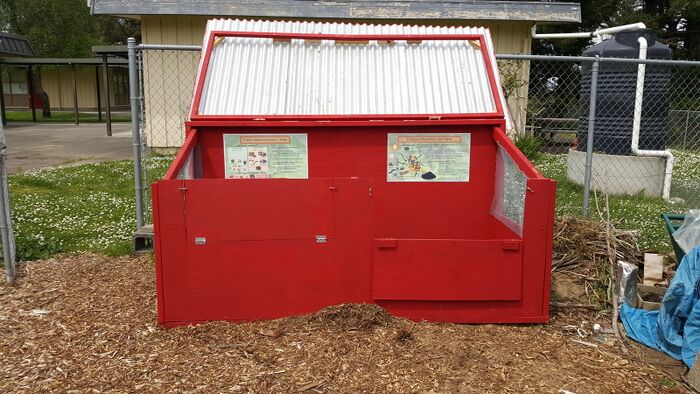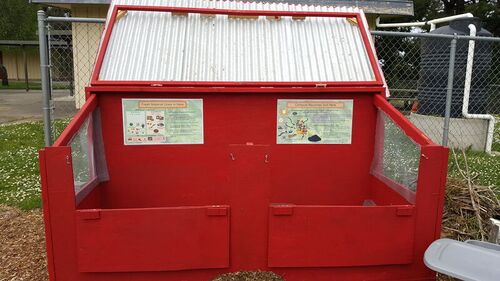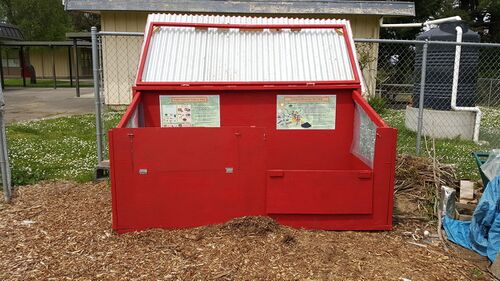No edit summary |
No edit summary |
||
| Line 1: | Line 1: | ||
{{Template:ENGR215inprogress|May 8th}} | {{Template:ENGR215inprogress|May 8th}} | ||
[[File:Zanecompost_onedoordown.jpg| | [[File:Zanecompost_onedoordown.jpg|700px|right|Finished composting bins]] | ||
==Abstract== | ==Abstract== | ||
Revision as of 05:31, 1 May 2017

Abstract
The objective of this project was to develop a cost-effective composting system that is durable, educational, and safe for children gardeners to use at Catherine L. Zane Middle School in Eureka, CA. As of spring 2017, teachers at Zane had tried to adopt a couple of different composting systems for the garden, but they had to be removed for a variety of reasons. The school requested a compost system that would be educational, safe, and able to accommodate garden waste, woody debris, and organic waste from the cafeteria. The new composter at Zane Middle School is a 2-bin system. The left-side bin is used for depositing fresh organic matter, while the right-side bin houses maturing compost. The structure is painted with weather-resistant paint, which prevents the wood from warping and postpones its decomposition. It is equipped with educational posters, and is lined with hardware cloth to detour rats. Each bin has a front door to encourage ease of access, although the corrugated steel roof is too heavy. In the future, a plastic or wood roof should be used.
Background
Catherine L. Zane Middle School in Eureka, CA focuses their curriculum around science, technology, engineering, art, and math (STEAM), and caters to a diverse group of children. Zane and the Environmental Resources Engineering department at Humboldt State University have a rich history of partnership around the STEM programs. As of spring 2017, the school had tried a couple of composting systems in the past, but were faced with a variety of problems including rats, the need for excessive maintenance, and destructive children, so they removed the compost altogether.
Problem statement and criteria
The objective of this project is to develop a cost-effective composting system that will be strong and safe for the children gardeners to use. This composter will be low-maintenance, simple to use, and will accommodate a variety of garden waste, woody debris, and the occasional organic waste from the cafeteria. The design will ensure the compost is free of pests such as rats and raccoons, and will be sturdy enough to stand up to the test of rowdy middle-schoolers.
| Criteria | Constraints | Weight (0-10 high) |
|---|---|---|
| Pet Resistance | Must be rat-proof | 8 |
| Maintenance | Maximum of five hours of maintenance each week | 5 |
| Durability | Must not be easily altered by middle-schoolers | 6 |
| Safety | Must not be sharp or splintery | 10 |
| Educational Value | Includes an appropriate display for middle-schoolers | 9 |
| Simplicity | The compost must be accessible to the middle-schoolers | 7 |
| Cost | Maximum cost is not to exceed $425 | 4 |
| Aesthetics | The aesthetics must agree with those of the garden and the school | 3 |
Description of final project
Include a how to use and maintain section. See the how to template below.
Costs
| Quantity | Material | Source | Cost ($) | Total ($) |
|---|---|---|---|---|
| 1 | Corrugated tin, 73 sq. ft. | Arcata Scrap and Salvage | 17 | 17 |
| 2 | Weather-Resistant Paint (quart) | Ace Hardware | 14.37 | 28.74 |
| 1 | Wood Glue | Ace Hardware | 3.99 | 3.99 |
| 2 | Hinge (small) | Ace Hardware | 4.59 | 9.18 |
| 1 | Hinge (large) | Ace Hardware | 5.99 | 5.99 |
| 1 | Corner Brace | Ace Hardware | 5.99 | 5.99 |
| 1 | Mending Brace | Ace Hardware | 7.99 | 7.99 |
| 2 | Hook & Eye Closures (2-pack) | Ace Hardware | 2.59 | 5.18 |
| 4 | 2 x 6 (Doug Fir) | Pierson's | 6.00 | 24.00 |
| 2 | 4 x 8 (Cedar) | Pierson's | 38.89 | 7.78 |
| 7 | 2 x 2 (Cedar) | Pierson's | 2.00 | 14.00 |
| 6 | 2 x 4 (cedar) | Pierson's | 3.84 | 23.04 |
| 20 | Wood Screws | Pierson's | 0.33 | 7.16 |
| 1 | Compost Thermometer | Amazon.com | 22.84 | 22.84 |
| 1 | Galvanized Mesh, 2'x50' 1/4" | Ron's Home and Hardware | 42.37 | 42.37 |
| Total Cost | $295.26 | |||
Testing Results
The first aspect tested was the area in the garden the composter would occupy. This was accomplished using cardboard and duct tape. After the frame was built, the doors were modeled from cardboard to test the accessibility with various sizes of doors.
How to build
Use Template:How_to
Maintenance
The following maintenance tasks should be completed as often as specified to ensure the ongoing success of the composting system [1]. Neglect of any of these tasks could result in the failure of the system to produce desirable soil.
Schedule
Complete the following tasks, as often as specified.
- Daily
- Add fresh compost to the bin on the left
- Make sure the lid and doors remain closed except when working with the compost
- Keep an eye on the temperature of both piles, relate to information found on the informational posters attached to the bins
- Weekly
- Turn the compost thoroughly on a weekly or bi-weekly basis, depending on temperature and moisture levels
- Monthly
- When the soil in the right side bin appears relatively homogeneous in texture, it can be added to the garden
- Move compost from the left-side bin to the right-side bin after the thermophilic phase
- Yearly
- Make sure the hardware cloth remains securely attached to the wood
- Every few years, as necessary
- Replace hinges and hooks
- Repaint/touch up with weather-resistant paint
- Re-apply the Gorilla Tape to the edges of the lid
- Replace the compost thermometer
Instructions
This is how to maintain. The step by step how to template {{How to}} is most likely best for this part.
Troubleshooting
This is a list of possible problems one may encounter during regular use, and steps to resolve those problems [2].
| Problem | Suggestion |
|---|---|
| The compost is dripping wet | Add dry browns (like sawdust) and mix thoroughly |
| The compost smells like methane | Mix thoroughly, and increase the normal frequency the pile is turned |
| The compost is too hot | Turn the pile and moisten if it's dry |
| The compost is too cold | |
| The gopher wire came undone from the wood | Staple the two back together with an industrial stapler (~14 mm staples) |
Discussion and next steps
Suggestions for future changes
This is where to lay out suggestions for how to make the project function better in the future.

